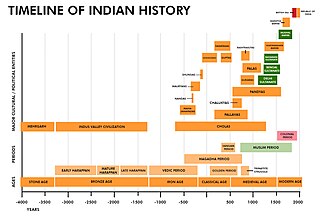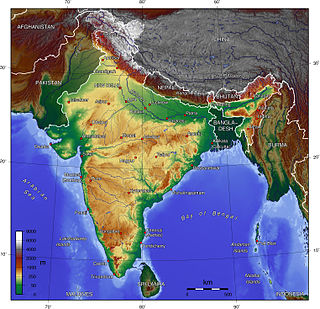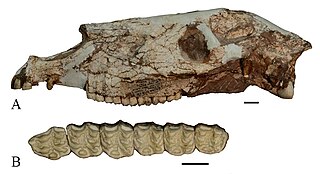
The Sivalik Hills, also known as the Shivalik Hills and Churia Hills, are a mountain range of the outer Himalayas. The literal translation of "Sivalik" is 'tresses of Shiva'. [1] Sivalik region is home to the Soanian archaeological culture. [2]

The Sivalik Hills, also known as the Shivalik Hills and Churia Hills, are a mountain range of the outer Himalayas. The literal translation of "Sivalik" is 'tresses of Shiva'. [1] Sivalik region is home to the Soanian archaeological culture. [2]

The Sivalik Hills are a mountain range of the outer Himalayas that stretches over about 2,400 km (1,500 mi) from the Indus River eastwards close to the Brahmaputra River, spanning the northern parts of the Indian subcontinent. It is 10–50 km (6.2–31.1 mi) wide with an average elevation of 1,500–2,000 m (4,900–6,600 ft). Between the Teesta and Raidāk Rivers in Assam is a gap of about 90 km (56 mi). [3] They are well known for their Neogene and Pleistocene aged vertebrate fossils. [4]
Geologically, the Sivalik Hills belong to the Tertiary deposits of the outer Himalayas. [5] They are chiefly composed of sandstone and conglomerate rock formations, which are the solidified detritus of the Himalayas [5] to their north; they are poorly consolidated. The sedimentary rocks comprising the hills are believed to be 16–5.2 million years old. [6]
They are bounded on the south by a fault system called the Main Frontal Thrust, with steeper slopes on that side. Below this, the coarse alluvial Bhabar zone makes the transition to the nearly level plains. Rainfall, especially during the summer monsoon, percolates into the Bhabar, then is forced to the surface by finer alluvial layers below it in a zone of springs and marshes along the northern edge of the Terai or plains. [7]
The Sivalik Hills are well known for fossils of vertebrates, spanning from the Early Miocene, until the Middle Pleistocene, around 18 million to 600,000 years ago. [8] [9]
Remains of the Lower Paleolithic Soanian culture dating to around 500,000 to 125,000 BP were found in the Sivalik region. [10] Contemporary to the Acheulean, the Soanian culture is named after the Soan Valley in the Sivalik Hills of Pakistan. The Soanian archaeological culture is found across Sivalik region in present-day India, Nepal and Pakistan. [2]
Sivapithecus (a kind of ape, formerly known as Ramapithecus) is among many fossil finds in the Sivalik region. [11]
A number of fossil ratites were reported from the Sivalik Hills, including the extinct Asian ostrich, Dromaius sivalensis and Hypselornis . However, the latter two species were named only from toe bones that have since been identified as belonging to an ungulate mammal and a crocodilian, respectively. [12]

This is a timeline of Indian history, comprising important legal and territorial changes and political events in India and its predecessor states. To read about the background to these events, see History of India. also see the list of governors-general of India, list of prime ministers of India and Years in India.

The Indo-Gangetic Plain, also known as the North Indian River Plain, is a 700-thousand km2 (172-million-acre) fertile plain encompassing northern regions of the Indian subcontinent, including most of modern-day northern and eastern India, most of eastern-Pakistan, virtually all of Bangladesh and southern plains of Nepal. Also known as the Indus–Ganga Plain, the region is named after the Indus and the Ganges rivers and encompasses a number of large urban areas. The plain is bounded on the north by the Himalayas, which feed its numerous rivers and are the source of the fertile alluvium deposited across the region by the two river systems. The southern edge of the plain is marked by the Deccan Plateau. On the west rises the Iranian Plateau. Many developed cities like Delhi, Dhaka, Kolkata, Lahore, Islamabad and Karachi are located in the Indo-Gangetic Plain.

Sivapithecus is a genus of extinct apes. Fossil remains of animals now assigned to this genus, dated from 12.2 million years old in the Miocene, have been found since the 19th century in the Sivalik Hills of the Indian subcontinent as well as in Kutch. Any one of the species in this genus may have been the ancestor to the modern orangutans.
Bhabar or Bhabhar is a region south of the Lower Himalayas and the Sivalik Hills in Garhwal and Kumaon, India. The Bhabhar region contains some of the largest cities of Kumaon and Garhwal: Dehradun, Haridwar, Haldwani, Ramnagar, Tanakpur and Kotdwar. It is the alluvial apron of sediments washed down from the Sivaliks along the northern edge of the Indo-Gangetic Plain.

The South Asian Stone Age covers the Palaeolithic, Mesolithic and Neolithic periods in the Indian subcontinent. Evidence for the most ancient Homo sapiens in South Asia has been found in the cave sites of Cudappah of India, Batadombalena and Belilena in Sri Lanka. In Mehrgarh, in western Pakistan, the Neolithic began c. 7000 BCE and lasted until 3300 BCE and the Chalcolithic and early Bronze Age. In South India, the Mesolithic period lasted until 3000 BCE, and the Neolithic period until c. 1000 BCE, followed by a Megalithic transitional period, mostly skipping the Bronze Age. The Iron Age in India began roughly simultaneously in North and South India, around c. 1200 to 1000 BCE.
The Sub-Himalayan Range is the southernmost mountains in the Himalayas, located on the Indian subcontinent. Their average height varies between 600 and 1,200 meters, and are not so high in altitude as compared to other mountain ranges in the Himalaya range. The range spans the modern-day countries of Pakistan, India, Nepal, and Bhutan.

The geology of Nepal is dominated by the Himalaya, the highest, youngest and a very highly active mountain range. Himalaya is a type locality for the study of on-going continent-continent collision tectonics. The Himalayan arc extends about 2,400 km (1,500 mi) from Nanga Parbat by the Indus River in northern Pakistan eastward to Namche Barwa by the gorge of the Tsangpo-Brahmaputra in eastern Tibet. About 800 km (500 mi) of this extent is in Nepal; the remainder includes Bhutan and parts of Pakistan, India, and China.

The Doon Valley is an unusually wide, long valley within the Sivalik Hills and the Lesser Himalayas, in the Indian states of Uttarakhand, Himachal Pradesh and Haryana. Within the valley lies the city of Dehradun, the winter capital of Uttarakhand state.

Indopithecus giganteus is an extinct species of large ape that lived in the late Miocene of the Siwalik Hills in northern India. Although frequently assigned to the more well-known genus Gigantopithecus, recent authors consider it to be a distinct genus in its own right.

Shivalik Fossil Park, also known as the Suketi Fossil Park, is a notified National Geo-heritage Monument fossil park in the Sirmaur district in the Indian state of Himachal Pradesh. It has a collection of prehistoric vertebrate fossils and skeletons recovered from the upper and middle Siwaliks geological formations of sandstones and clay at Suketi. The Siwalik ranges are located in the outer Himalayas. The park has a display of the fossil finds and an open-air exhibition of six life-sized fiberglass models of extinct mammals in a recreation of the Sivalik Hills environment of the Plio-Pleistocene era. A museum, within the precincts of the park curated and exhibits the fossils. Shivalik is Asia's biggest fossil park. The exhibits in the park are used to generate scientific interest among the public, and facilitate special international studies by visiting research scholars from all over the world.
The Soanian culture is a prehistoric technological culture from the Siwalik Hills, Pakistan. It is named after the Soan Valley in Pakistan.

The Indian Himalayan Region is the section of the Himalayas within the Republic of India, spanning thirteen Indian states and union territories, namely Ladakh, Jammu and Kashmir, Himachal Pradesh, Uttarakhand, Sikkim, West Bengal, Manipur, Meghalaya, Mizoram, Nagaland, Tripura, Assam, and Arunachal Pradesh. The region is responsible for providing water to a large part of the Indian subcontinent and contains various flora and fauna.

The topography of Pakistan is divided into seven geographic areas: the northern highlands, the Indus River plain, the desert areas, the Pothohar Plateau, Balochistan Plateau, Salt Range, and the Sistan Basin. All the rivers of Pakistan, i.e. Sindh, Ravi River, Chenab River, Jhelum River, and Sutlej River, originate from the Himalayas mountain range. Some geographers designate Plateau as to the west of the imaginary southwest line; and the Indus Plain lies to the east of that line.
Crocodylus palaeindicus is an extinct species of crocodile from southern Asia. C. palaeindicus lived from the Miocene to the Pliocene. It may be an ancestor of the living Mugger crocodile.

The Garhwal Himalayas are mountain ranges located in the Indian state of Uttarakhand.

Gavialis browni is an extinct species of the crocodylian genus Gavialis and a close relative of the living gharial Gavialis gangeticus.

The Himalayan foreland basin is an active collisional foreland basin system in South Asia. Uplift and loading of the Eurasian Plate on to the Indian Plate resulted in the flexure (bending) of the Indian Plate, and the creation of a depression adjacent to the Himalayan mountain belt. This depression was filled with sediment eroded from the Himalaya, that lithified and produced a sedimentary basin ~3 to >7 km deep. The foreland basin spans approximately 2,000 kilometres (1,200 mi) in length and 450 kilometres (280 mi) in width. From west to east the foreland basin stretches across five countries: Pakistan, India, Nepal, Bangladesh, and Bhutan.

Sivalhippus is an extinct genus of horse that lived in Africa and the Indian subcontinent during the late Miocene.

Enhydriodon is an extinct genus of mustelids known from Africa, Pakistan and India that lived from the late Miocene to the early Pleistocene. It contains nine confirmed species, two debated species, and at least a few other undescribed species from Africa. The genus belongs to the tribe Enhydriodontini in the otter subfamily Lutrinae. Enhydriodon means "otter tooth" in Ancient Greek and is a reference to its dentition rather than to the Enhydra genus, which includes the modern sea otter and its two prehistoric relatives.
Hypselornis is an extinct genus of fossil reptile, most likely a crocodilian, from the late Pliocene of India. Known only from a single toe bone, Hypselornis was originally mistakenly identified as a ratite bird related to the living cassowary before being re-identified as belonging to a large reptile, probably a crocodilian.